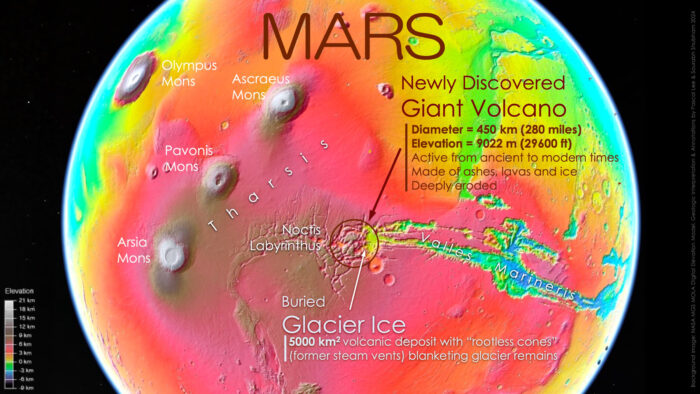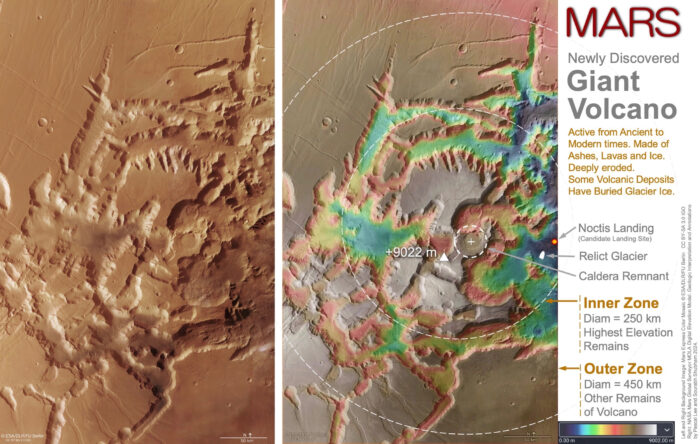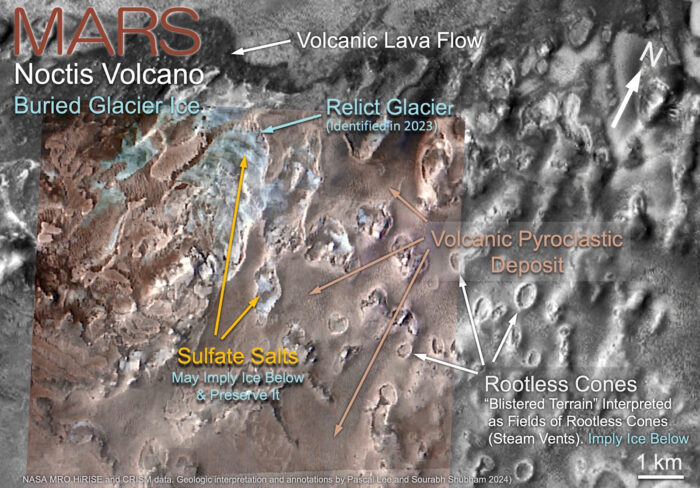Astronomers in Houston announced a Texas-sized discovery on the Red Planet that had hidden in plain sight for decades.
A volcano taller than Mt. Everest towers among deep canyons near Mars’ equatorial Noctis Labyrinthus (Labyrinth of the Night) region — and may hide a sheet of glacier ice.
The discovery “points to an exciting new location to study Mars’ geologic evolution through time, search for life, and explore with robots and humans in the future,” said a press release from SETI.

Location of the Noctis volcano between the largest volcanic and canyon provinces on Mars. Image: Background image: NASA Mars Global Surveyor (MGS) Mars Orbiter Laser Altimeter (MOLA) digital elevation model. Geologic interpretation & annotations by Pascal Lee and Sourabh Shubham 2024
Hidden giant
The “Noctis volcano,” as it’s called until it receives an official name, hulks over its surroundings at an enormous 9,022m. That’s about 170m taller than Everest, if you’re counting. And if you think it’s amazing that it’s possible to calculate the height of a mountain 140 million miles away to that degree of accuracy, consider this: astronomers first saw the Noctis volcano more than 50 years before they recognized it existed.
NASA’s Mariner 9 became the first spacecraft to orbit another planet when it reached Mars in 1971. It captured images of the Noctis Labyrinthus region — but analysts still couldn’t tell they were looking at a gigantic volcano.
It’s a geographically complex area. Noctis Labyrinthus is a jumble of slot canyons, carved narrow and deeply into the Martian surface. Those give way to the Valles Marineris (Valleys of the Mariner), which are broader, larger canyon structures. The newly discovered volcano thrusts upward from the area where they meet.
According to SETI, elevated mesas form an arc that surrounds the remnants of a collapsed caldera. Sloping foothills range outward from this fractured summit to a staggering distance of 225km. There, research teams observed lava flows, scattered deposits of volcanic ash, cinders, and pumice — plus hydrated mineral deposits.

The topographic map at right shows the ‘relict glacier’ discovered in 2023 and Noctis Landing, a candidate site for future robotic and human exploration. Image: Left: Mars Express HRSC color mosaic © ESA/DLR/FU Berlin CC BY-SA 3.0 IGO; Right: Background image: same as Left; NASA MGS MOLA digital elevation model. Geologic interpretation and annotations by Pascal Lee and Sourabh Shubham 2024.
Wet feet?
These deposits have drawn the attention of SETI and others. The vast Martian field they’re buried under looks “blistered,” the researchers found. In extraterrestrial geographic terms, the structures are “rootless cones,” or mounds caused by explosive steam venting when a thin blanket of hot volcanic materials coats a water or ice-rich surface below.

‘Rootless cones’ are steam vents produced when hot pyroclastic materials came in contact with water ice. Image: Background images: NASA Mars Reconnaissance Orbiter (MRO) High Resolution Imaging Science Experiment (HiRISE), Context Imager (CTX), and Compact Reconnaissance Imaging Spectrometer for Mars (CRISM). Geologic interpretation and annotations by Pascal Lee and Sourabh Shubham 2024.
To gain any further insights, researchers will need to discover whether closer exploration is feasible. They can’t yet tell whether the volcano is still active, and “catastrophic collapses” have wracked its surface before, SETI said.
But exciting opportunities could lie ahead.
“Humans could potentially explore a less frigid part of the planet while still being able to extract water for hydration and rocket fuel,” SETI speculated.
Though NASA hasn’t set a boots-on-the-ground date for a Mars mission, the application period for the next Martian module test crew is open for two more weeks.






